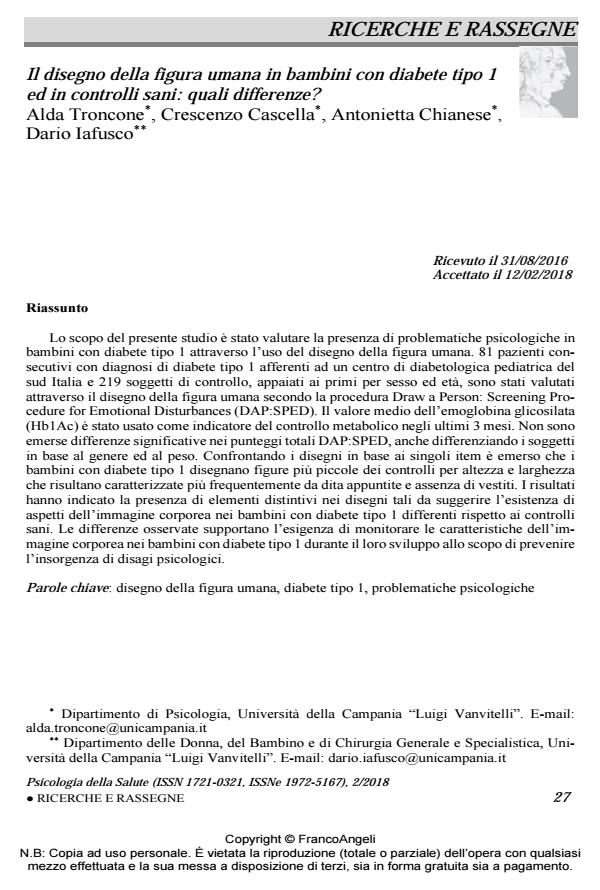The human figure drawing in children with type 1 diabetes and healthy control individuals: What differences?
Journal title PSICOLOGIA DELLA SALUTE
Author/s Alda Troncone, Crescenzo Cascella, Antonietta Chianese, Dario Iafusco
Publishing Year 2018 Issue 2018/2
Language Italian Pages 18 P. 27-44 File size 264 KB
DOI 10.3280/PDS2018-002006
DOI is like a bar code for intellectual property: to have more infomation
click here
Below, you can see the article first page
If you want to buy this article in PDF format, you can do it, following the instructions to buy download credits

FrancoAngeli is member of Publishers International Linking Association, Inc (PILA), a not-for-profit association which run the CrossRef service enabling links to and from online scholarly content.
The purpose of this study was to evaluate the presence of psychological problems in children with type 1 diabetes by using human figure drawings. A total of 81 consecutive patients attending an Southern Italian university pediatric diabetology centre with a diagnosis of type 1 diabetes, along with 219 control subjects matched to the study group for age and gender, were asked to draw human figure drawings according to the Draw a Person: Screening Procedure for Emotional Disturbances (DAP:SPED). The glycosylated hemoglobin (HbA1C) mean value, measured every 3 months over the past year, was used as a measure of metabolic control. No significant differences between the children with type 1 diabetes and controls in the DAP:SPED total scores were observed, even when they were differentiated by gender or by weight An item by item human figure drawings comparison showed that the children with type 1 diabetes drew smaller figures for height and width than the controls, with more frequent presence of pointed fingers and the absence of clothes. Findings indicated the presence of distinctive elements in human figure drawings suggesting the existence of aspects of body image which characterize children with type 1 diabetes and distinguish them from healthy children. The differences observed support the need for monitoring the characteristics of body image in children with type 1 diabetes during the course of the development in order to increase the efficacy of early action to prevent the onset of psychological problems.
Keywords: Human figure drawing, type 1 diabetes, psychological problems
Alda Troncone, Crescenzo Cascella, Antonietta Chianese, Dario Iafusco, Il disegno della figura umana in bambini con diabete tipo 1 ed in controlli sani: quali differenze? in "PSICOLOGIA DELLA SALUTE" 2/2018, pp 27-44, DOI: 10.3280/PDS2018-002006